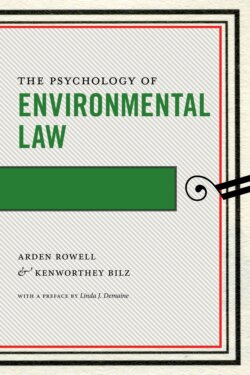Читать книгу The Psychology of Environmental Law - Arden Rowell - Страница 13
What Is Psychological About Environmental Law?
ОглавлениеThroughout this book, we will build upon the common view within environmental legal scholarship that environmental law and legal institutions must address the distinctive characteristics of environmental injury. What we add to this discussion is an argument that the distinctive characteristics of environmental injury also have distinctive psychological implications—and that recognizing and understanding these implications can help environmental law by informing how people perceive, respond to, value, and make decisions about the environment. Furthermore, and as we will see, where environmental law fails to incorporate insights from psychology, it risks misunderstanding and mispredicting human behaviors that affect the environment, and therefore misprescribing legal tools to shape those behaviors.
Though we follow Lazarus’s lead in focusing on the distinctiveness of environmental injury, our approach to exploring environmental harm differs somewhat from his. This should not be surprising; Lazarus was particularly focused on judicial decision making and in helping courts to see what and where they might want to think about environmental injury as a logically separate category. Our focus is different—broader in some ways and narrower in others. We aim to address what makes environmental law not just generally distinctive but psychologically distinctive. To our knowledge, we are the first to explore this question. And so we think it is reasonable to channel our focus toward those aspects of environmental law about which psychological processes have something helpful to impart.
To this end, we believe it is helpful to boil down the key psychological aspects of environmental injury into three general concerns. These are that environmental impacts tend to be (1) diffuse through time and space; (2) complex, insofar as they are interactive with other human behaviors, nonlinear in their impacts, and multicausal; and (3) nonhuman in character, insofar as they implicate and interact with nonhuman “natural” processes and implicate nonhuman stakeholders. (Though this list differs from Lazarus’s typology, readers familiar with his work will still note the substantial influence of it.) We have a great deal more to say about each of these characteristics, and we devote a chapter to each. As a very general thumbnail sketch, however, we will suggest that the diffuse quality of environmental impacts makes environmental injury difficult to perceive; the complex nature of environmental impacts makes them difficult to understand; and the nonhuman character of environmental impacts makes them difficult to care about. These three characteristics, we argue, can explain a wide range of environmental behaviors. At the same time, failing to account for these characteristics can undermine the ability of environmental laws to effectively implement preferred environmental policies.
We hope that readers will find this structure to be helpful in addressing the distinctive character of environmental law, as it relates to environmental injury and the natural world. That said, psychology also has other and more general lessons to offer law, including environmental law, and many general law and psychology resources will also be valuable to environmental scholars and practitioners, just as they are to scholars and practitioners in other areas of law. While general law and psychology resources are available elsewhere, we devote a chapter to more general psychological phenomena, and highlight where they specifically interact with environmental impacts.
